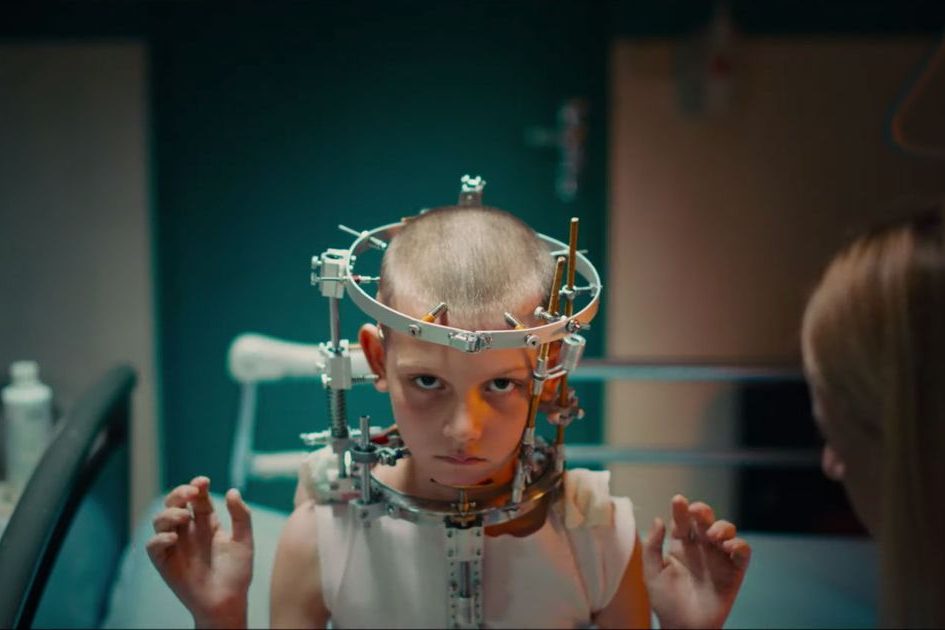This is the latest volume of the French Dispatches, our on-the-ground coverage of the 74th Cannes Film Festival, which is back in 2021 after a yearlong hiatus due to COVID-19. Watch this space over the next fortnight for more.
Titane did a good job of keeping its secrets and building anticipation for its premiere Tuesday night. Writer-director Julia Ducournau’s first feature, Raw, was a major breakthrough in Cannes’s smaller Critics’ Week section in 2016: a film about a virginal vegan veterinary student who comes of age and into a taste for human flesh, it earned gasps when its heroine eats a severed finger, and then got grosser from there. The logline for Ducournau’s followup, now in the main competition, was cryptic: “Following a series of unexplained crimes, a father is reunited with the son who disappeared ten years ago. Titane: A metal highly resistant to heat and corrosion, with high tensile strength alloys, often used in medical prostheses due to its pronounced biocompatibility.” “Titane” means “titanium.” The preview didn’t help much: it was just a sequence of extreme but nearly incoherent images of car-show honeys twerking on hot rods, the steroidal French star Vincent Lindon flexing in front of a mirror, metal protheses, et cetera. It promised an autoerotic treatise on body modification and tons of gnarly setpieces —and exceeded expectations in a deluge of blood, fire and motor oil.
Following a childhood car accident, Alexia (heretofore unknown Agathe Rouselle) has a titanium plate in her head, which goes well with her half-blonde mullet and the “Love is a dog from hell” tattoo between her breasts. She’s one of the girls at the hilariously pornographic car show, wearing booty shorts and fishnets, humping ecstatically on the hood of an El Dorado with flames painted all over it, as well as a hydraulic system that eventually gets quite the workout. Ducournau frontloads much of Titane’s body-horror stuff, throwing us right into the film’s motifs of vulnerable flesh and hard metal when Alexia gets her hair caught in another girl’s nipple piercing. But after a very gory first act, the narrative shifts into a quite tender (but still darkly hilarious and perverse) story of found families, with Alexia somehow ending up the ward of a fire station in which Lindon is the undisputed Daddy of a hothouse full of glistening chrome and hard bodies.
Raw had a strong central allegory about a young woman discovering her “appetites,” whereas Titanium feels more like a series of riffs on a set of themes related to hybridity: hybridity of gender identity, film genre, family, even what it means to be human. Or, instead of hybridity, refer back to the logline: Biocompatibility. Titane’s trailer begged comparisons to Crash (the sex-and-car-crashes Crash, not the post-racial Crash), and the comparison between David Cronenberg and Ducournau remains throughout the film — not just in her film’s body-horror spectacle and transhumanist subject matter, but its feel for proposing original, open-ended and totally buck-wild metaphors, like Cronenberg did in Videodrome. I don’t think it’s too much of a spoiler to say that the first words out of my mouth at the end of Titane were “Long live the new flesh.”
If that is a spoiler, then apologies — with Titane more than most films at Cannes, I don’t want to reveal too much. Ducournau is very consciously working the audience, both with her narrative’s swerves and shocks, and with her assured staging of sex and violence. She doesn’t do a lot of jump scares, preferring to give you time to anticipate the moment, but uses the build-up to play a little audio-visual game with you, so you’re always wondering whether this skin-piercing, bone-crunching moment will be done with practical gore effects or offscreen sound. It’s the kind of film that’s best seen with an audience feeding on its own energy — and, yes, its gratitude for the experience.
Titane inspired a lot of breathless first-look reactions from the kind of festival-goers who are so excited to share the moment that they can’t help but overshare afterwords, turning every moment of the film into an instant meme for Twitter followers who haven’t had a chance to see the movie yet. This does get asses in seats — and I think Annette’s PR team erred in not releasing stills of the Baby Annette immediately after the opening night screening; they could have extended the movie’s news cycle at least until Benedetta screened on the first weekend if they’d done it — and it can prime an audience to be receptive to the movie. But maybe too receptive? By giving away everything Ducournau has in mind for the audience, you’re reducing Titane to a Greatest Hits setlist. A sense of surprise — of discovery — is so crucial to what Ducournau is doing with this film, and without that sucker-punch adrenaline it’s possible that this genuinely risky film will seem pat and pre-chewed.
Over at Screen Daily’s running grid of international critics’ star ratings of competition films, Titane is languishing near the bottom, with the more or less forgettable (Nanni Moretti’s Three Floors, which I skipped) and the definitely execrable (Sean Penn’s Flag Day, which I wish I had). So it’d be a big upset if the film won anything at Saturday’s awards ceremony, but Titane, in addition to being the moment in the festival where I’ve felt most giddy about the sheer privilege of being here, feels like a culmination of a lot of the festival’s trends. It’s a lot of movie. It has iconic cars, like critics’ fave Drive My Car, a three-hour Haruki Murakami adaptation in which some formally daring and emotionally cathartic conversation happens in a beautiful cherry-red Saab 900 Turbo. It has muscular boys dancing out their feelings, like dissident Israeli filmmaker Nadav Lapid’s prickly, self-reflexive Ahed’s Knee. And thanks to Agathe Rouselle — who gives an incredible, nearly silent performance, and once feral and robotic — it has both lactation and some very extensive, committed and compelling naked acting by a female performer who carries the movie.
One of the movies I’m talking about when I mention lactation and naked female stars is Cow, Andrea Arnold’s vérité documentary about a dairy cow named Luma (shout-out to Luma, a legend). Another is Benedetta, Paul Verhoeven’s lesbian nun movie, based on the true(?) story of Sister Benedetta of Pescia, a 17th century nun who fell afoul of the Catholic church hierarchy for her mystical visions and lesbian relations with a fellow sister. Played by Virginie Efira with a devilish charisma and divine conviction, Benedetta is a sort of avenging-angel of history, who slashes through the Church’s political and and financial machinations and a historical backdrop of the Black Plague, while Verhoeven gooses his audience with a number of instant memes that are like dirty doodles in the margin of a Sunday-school Bible: visions of a Sexy Jesus, a figurine of the Blessed Virgin used for some decidedly unvirginal purposes. Verhoeven throughout his career, from Basic Instinct to Starship Troopers to Black Book, has been interested in power, in all its manifestations — aesthetic, political, and sexual. But in Benedetta, like in Titane, the most intense and knotty power dynamic is the one between filmmaker and audience.
This article appeared in an InsideHook newsletter. Sign up for free to get more on travel, wellness, style, drinking, and culture.

























